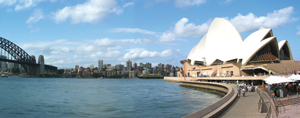Getting the show on the road
How does a touring agent in Australia go about planning a four-month tour of 43 venues spanning more than 7.5 million square kilometres? Harpreet Kaur shares her experiences

Australia is more than 30 times the size of the UK, which makes the logistics of touring a key difference between the two countries. The way tours are scheduled, funded and delivered is quite different. Getting from one side of the country to the other is a major challenge, so budgets in Australia have to allocate much more to freight, flights and time, and artists need to be paid adequately and given reasonable breaks and days off. Then there’s the time needed to do the get-in, and lighting and sound checks. So the scheduling becomes even more complex. Many commercial producers will go directly to presenters to book dates, but small, not-for-profit producers do not have the time, funds or expertise to compete with the big boys. Consequently, a presenter-driven touring model operates in Australia, and many producers work closely with touring agencies to get their shows on the road.
An impressive infrastructure has been developed to co-ordinate tour scheduling. A showcase of different work, Long Paddock, takes place annually in one venue so that producers and presenters can see the work available for touring. Travelling up and down such a huge country to see productions would not work. Presenters can then vote for productions they are interested in booking through an online resource called Cyberpaddock. Regional touring agencies then build time- and cost-efficient itineraries for the popular shows.
‘Playing Australia’ is the Australian Government’s performing arts touring programme, designed to assist the touring of performances across state and territory boundaries where this would not commercially viable but there is a public demand. The funds do not necessarily get allocated evenly between producers from the six Australian states, and the decisions are not based largely on artistic merit. Successful projects demonstrate strong presenter interest and have a robust financial and logistics plan. The nature of the funding cycle and venue programming means that everyone is constantly playing catch up; there is no time to reflect on long-term strategy or test different approaches, let alone think about the impact of technology, changing consumer behaviour or the need for leadership development. The focus is largely on delivery and short-term outputs. “If the Australia Council managed touring funding, the programme could be far more responsive, strategic, nimble,” says Lindy Allen, Chief Executive Officer of Regional Arts Victoria (RAV).
RAV, based in Melbourne, is one of the six state-funded touring agencies and has been touring nationally for more than 40 years. In 2010, RAV’s tours spanned more than 318,000 km. This work is done by its ‘Arts Across Victoria’ team, comprising just four core members of staff. As well as being a key player in a national touring network and a major resource for both producers and presenters, RAV also produces Showcase Victoria to bring together producers and presenters from Victoria every year. Resources are limited in Australia as they are in the UK, but it’s surprising what you can achieve with strong networks and a well-developed infrastructure. Various associations have been developed to ensure closer links, better planning and more collaborative activities, such as the Australian Association of Performing Arts, which does not have an equivalent in the UK. The system here is impressive, but unfortunately the distance to be covered means that less of the pie goes to creative development and audience development initiatives.
Theatres and arts centres in the UK tend to develop relationships with producers over time, sometimes co-producing and co-commissioning work. However, many of the presenters in Australia, especially in regional towns, cannot be more than receiving houses and do not necessarily have an artistic programming policy. They are less likely to take risks. This is not to say that more innovative work does not reach different corners of the country: Performing Lines, for example, is a touring agency designed specifically to produce and tour non-mainstream work, be it indigenous, intercultural, hybrid or contemporary. As in England’s main cities and towns, cities such as Melbourne, Sydney and Brisbane have plenty of commissions, co-productions and collaborations, so there is plenty of room for edgy challenging work. There is, however, a difference in programming between urban, rural, metropolitan, and regional and remote areas.
There are specialised touring agencies, such as Kultour, which supports the touring of multicultural arts across Australia advocating for cultural diversity in the arts. Kultour’s aim is to ensure that the cultural diversity of Australia is represented. Touring is also a priority for the Melbourne Fringe Festival: “The emphasis will be on developing infrastructure-flexible work that can tour readily,” explains Esther Anatolitis, Chief Executive Officer of Melbourne Fringe. The Fringe offers specific producer support in this area. So, there are a variety of models being put into practice for commercial, independent, culturally diverse and mainstream producers.
The UK can celebrate its reputation for pioneering many areas of arts management practice, but needs to keep a close eye on what colleagues around the world are initiating. Continuing international dialogue is key. The current economic situation is a hiccup – an opportunity to reposition, reflect and adjust.

Join the Discussion
You must be logged in to post a comment.